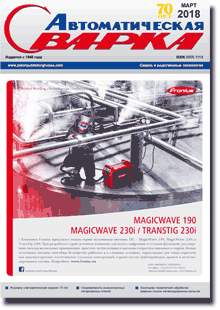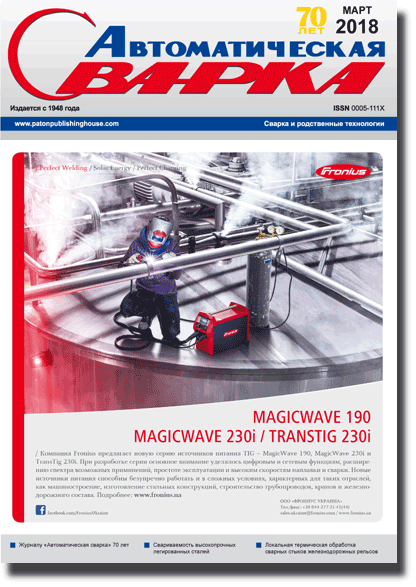| 2018 №03 (09) |
DOI of Article 10.15407/as2018.03.01 |
2018 №03 (02) |

Avtomaticheskaya Svarka (Automatic Welding), № 3, 2018, pp. 7-12
Weldability of high-strength alloyed steels with yield strength OF 590...785 MPa
V.D. Poznyakov
E.O. Paton Electric Welding Institute of the NAS of Ukraine. 11 Kazimir Malevich Str., 03150, Kyiv. E-mail: office@paton.kiev.ua
This paper summarizes the results of investigations of influence of the thermal cycles, characteristic for arc welding processes, on the structure and mechanical properties of high-strength alloyed steels with yield strength of 590...785 MPa, as well as on their tendency to cold cracks formation. The structural transformations in the metal of heat-affected-zone of welded joints were investigated using a quick-response dilatometer, and its mechanical properties and tendency to cold cracks formation were evaluated according to the results of tests of standard specimens and by the Implant method, respectively. The diagrams of the structural transformations of austenite in the area of metal overheating of heat-affected-zone of a number of high-strength alloyed steels, the dependence of change of their mechanical properties during welding, and also the data, characterizing the tendency of high-strength alloyed steels to cold cracks formation at different concentrations of diffusion hydrogen in the deposited metal, are presented. 15 Ref., 4 Tab., 4 Fig.
Keywords: high-strength steels, arc welding, metal structure, mechanical properties, cold cracks
References
1. Show B. K., Veerababu R., Balamuralikrishnan R., Malakondaiah G. (2010) Effect of vanadium and titanium modification on the microstructure and mechanical properties of microalloyed HSLA steel. Materials Science and Engineering A, 527, 1595–1604. https://doi.org/10.1016/j.msea.2009.10.049
2. Paton, B.E., Medovar, B.I., Tikhonov, V.A. et al. (1984) Examination of possibility of quality improvement of thicksheet high-strength structural steels 12GN2MFAYu (VS-1) and 12Kh2MFBAYu (VS-2) using electroslag remelting method. Problemy Spets. Elektrometallurgii, 21, 3-7 [in Russian].
3. Paton, B.E., Medovar, B.I., Tikhonov, V.A. et al. (1985) Electroslag remelting of high-strength structural steels 12GN2MFAYu (VS-1) grade under fluxes containing rareearth metals. Ibid., 1, 5-7 [in Russian].
4. Pokhodnya I. K., Shvachko V. I. (1996) Cold cracks welded joint of structural steels. Materials Science and Engineering, 32, 1, 45–55. https://doi.org/10.1007/BF02538924
5. Stevenson M. E., Lowrie S. L., Bowman R. D., Bennett B. A. (2002) Metallurgical failure analysis of cold cracking in a structural steel weldment: Revisiting a classic failure mechanism. Practical Failure Analysis, 2, 55–60. https://doi.org/10.1007/BF02715454
6. Garašić I., Ćorić A., Kožuh Z., Džić I. (2010) Occurrence of cold cracks sn welding of high-strength S960 QL steel. Technical Gazette, 17, 327–335.
7. Lobanov, L.M., Poznyakov, V.D., Makhnenko, O.V. (2013) Formation of cold cracks in welded joints from high-strength steels with 350-850 MPa yield strength. The Paton Welding J., 7, 7-12.
8. Keehan E., Zachrisson J., Karlsson L. (2010) Influence of cooling rate on microstructure and properties of high strength steel weld metal. Science and Technology of Welding and Joining, 15, 233–238. https://doi.org/10.1179/136217110X12665048207692
9. Svensson L.-E. (2007) Microstructure and Properties of High Strength Weld Metals. Materials Science Forum, 539-543, 3937–3942. https://doi.org/10.4028/www.scientific.net/MSF.539-543.3937
10. Ragu Nathan S., Balasubramanian V., Malarvizhi S., Rao A. G. (2015) Effect of welding processes on mechanical and microstructural characteristics of high strength low alloy naval grade steel joints. Defence Technology, 11, 3, 308–317. https://doi.org/10.1016/j.dt.2015.06.001
11. Ghazanfari† H., Naderi M. (2013) Influence of Welding Parameters on Microstructure and Mechanical Performance of Resistance Spot Welded High Strength Steels. Acta Metall. Sin. (Engl. Lett.), 26, 5, 635–640.
12. Ghazanfari H., Naderi M., Iranmanesh M., Seydi M. (2012) A comparative study of the microstructure and mechanical properties of HTLA steel welds obtained by the tungsten arc welding and resistance spot welding. Materials Science and Engineering, 534, 90–100. https://doi.org/10.1016/j.msea.2011.11.046
13. Shorshorov, M. Kh., Belov, V.V. (1972) Phase transformations and changes of steel properties in welding. Moscow, Nauka [in Russian].
14. Sarzhevsky, V.A., Sazonov, V.Ya. (1981) Unit for simulation of welding thermal cycles based on the machine MSR-75. Avtomatich. Svarka, 5, 69-70 [in Russian].
15. Pokhodnya, I.K., Paltsevich, A.P. (1980) Chromatographic method for determination of diffusion hydrogen amount in welds. Ibid., 1, 37-39 [in Russian].
The cost of subscription/purchase order journals or individual articles
| Journal/Currency | Annual Set | 1 issue printed |
1 issue |
one article |
| TPWJ/USD | 384 $ | 32 $ | 26 $ | 13 $ |
| TPWJ/EUR | 348 € | 29 € | 24 € | 12 € |
| TPWJ/UAH | 7200 UAH | 600 UAH | 600 UAH | 280 UAH |
| AS/UAH | 1800 UAH | 300 UAH | 300 UAH | 150 UAH |
| AS/USD | 192 $ | 32 $ | 26 $ | 13 $ |
| AS/EUR | 180 € | 30 € | 25 € | 12 € |
| SEM/UAH | 1200 UAH | 300 UAH | 300 UAH | 150 UAH |
| SEM/USD | 128 $ | 32 $ | 26 $ | 13 $ |
| SEM/EUR | 120 € | 30 € | 25 € | 12 € |
| TDNK/UAH | 1200 UAH | 300 UAH | 300 UAH | 150 UAH |
| TDNK/USD | 128 $ | 32 $ | 26 $ | 13 $ |
| TDNK/EUR | 120 € | 30 € | 25 € | 15 € |
AS = «Automatic Welding» - 6 issues per year;
TPWJ = «PATON WELDING JOURNAL» - 12 issues per year;
SEM = «Electrometallurgy Today» - 4 issues per year;
TDNK = «Technical Diagnostics and Non-Destructive Testing» - 4 issues per year.





